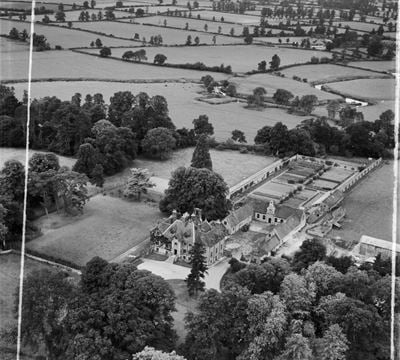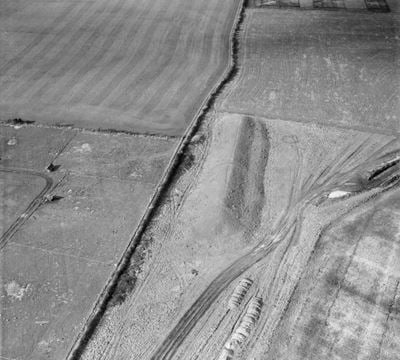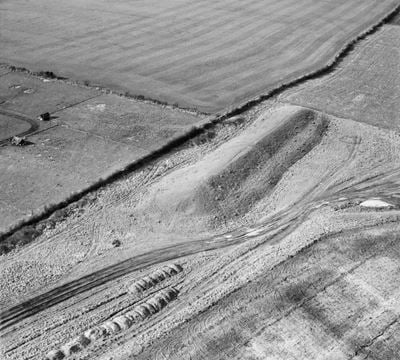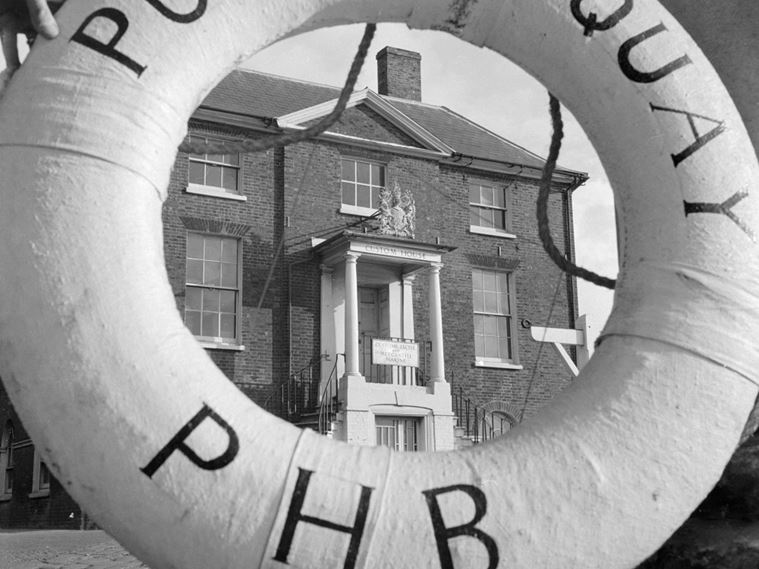Dorset
Explore hidden histories, historic photos, and things you never knew about Dorset from the collections and archives of Historic England.
Discover your local listed buildings and places
Introducing some of Dorset's most historic sites, included in the National Heritage List for England. Some of these captions have been summarised by AI. Click through for the official List entry. Skip this section and go to place by numbers
Poole Park
Poole
Poole Park, designed by John Elford, was created in the late 19th century as a public space with a salt-water lake and various amenities. It retains its original layout today.
Bridehead
Littlebredy
Bridehead is an early 19th-century park and garden, known for its ornamental village designed by Peter Frederick Robinson and Benjamin Ferrey.
Bingham's Melcombe
Hilton
Bingham's Melcombe, with 16th-century formal gardens, was restored in the mid-20th century by Sir Geoffrey Jellicoe and Brenda Colvin. The estate features historical gardens and woodland.
Valentine Tank Assemblage, Poole Bay
Studland Bay, Dorset. Centred on NGR SZ07035 85203.
Exercise SMASH was a live-fire rehearsal for D-Day undertaken at Studland, Dorset, in April 1944. Of particular interest was the testing of a new variation of tank.
Dorset and East Devon Coast
Abbotsbury
The official listing for all World Heritage sites is held by UNESCO and can be found on their website.
Nash Court, Manor House and Nash Lodge
Marnhull
Nash Court (now three dwellings currently known as Nash Court, Manor House and Nash Lodge) is a substantial house originating in the late C16/C17, with alterations and additions in the C18,...
Former Royal Naval Cordite Factory
Wareham St. Martin
Former explosives factory of 1916 for the Royal Navy. Variously updated and reconstructed until production ceased in 1945, though parts of the site remained in use until 1997.
Charborough Park
Lytchett Matravers
Charborough Park evolved from a 17th-century estate, notable for its association with the Glorious Revolution and visits by Frederick, Prince of Wales.
The Dorset Martyrs Memorial
Dorchester
A public sculpture by Elisabeth Frink commemorating those who in the C16 and C17 had been executed for their religious beliefs at Gallows Hill in Dorchester, designed in 1983 and installed...
The Rings: a ringwork and bailey and a Civil War battery …
Corfe Castle
The Rings, a medieval ringwork and bailey with Civil War battery near Corfe Castle, illustrate fortification reuse across centuries, notably from the 12th to 17th centuries.
Kingston Lacy
Pamphill
Kingston Lacy has rich historical connections, including links to the de Lacy family, Lady Margaret Beaufort, and transformations by the Bankes family over the centuries.
Former RAF Ringstead Chain Home radar station
Osmington
The structural remains of RAF Ringstead Chain Home Radar Station (AMES12B), built in 1941.
Mortar Wreck
On the western side of the Swash Channel on the approaches to Poole Harbour.
Mortar Wreck is the remains of a clinker-built, sea-going vessel, built of Irish oak and dated by dendrochronology (tree-ring dating) to the mid-13th century.
Manor Farm Barn
Winterborne Clenston
Tithe barn. Built in the mid-C16, incorporating a reused, late C15 roof. Read the official list entry to find out more.
HM submarine A3
10.2 km south of Worbarrow Tout, Dorset
HM submarine A3 was built by Vickers, Sons & Maxim Ltd. in Barrow-in-Furness. She was launched in March 1903 and commissioned on 13th July 1904.
Kingston Maurward
Stinsford
Kingston Maurward features 18th-century parkland and lake with early 20th-century gardens by Sir Cecil and Lady Hanbury. Historical figures include George Pitt and Thomas Hardy.
Milton Abbey
Hilton
An extensive landscape park laid out in the second half of the C18 by Lancelot Brown. Read the official list entry to find out more.
Minterne House
Minterne Magna
A late-C18 park incorporating the remains of an early-C18 park and a rhododendron collection started in the late C19 and early C20. Read the official list entry to find out more.
Earthworks on Giant Hill
Cerne Abbas
Giant Hill features an enclosure, bowl barrow, and earthwork representing continuous habitation, providing insights into early community beliefs and prehistoric landscape use.
Tudor Grange
Bournemouth
Hotel, originally a private house, 1928, by WH Mackenzie and RA Phillips for Mrs CG Knight. Read the official list entry to find out more.
St Martin's Church
Wareham Town
St Martin's Church features varied architecture, surviving wall paintings, and reflects insights into medieval life and population levels, emphasizing its historical significance.
Downe Hall
Bridport
Downe Hall, elevated north of Bridport, features picturesque views towards the sea. Designed for William Downe, its late 18th-century park and gardens were later enhanced by E S Prior.
Parnham House
Beaminster
Early C20 formal gardens, often attributed to Francis Inigo Thomas. Read the official list entry to find out more.
Parish Church of Lady St Mary
Wareham Town
A Saxon minster of the 8th century, with south chapel of the 12th century, much early 14th century work in the chancel; west tower probably early 16th century.
Hill figure called The Giant
Cerne Abbas
Hill figures like 'The Giant' are rare monuments, often interpreted as religious symbols.
Dudsbury camp
Ferndown Town
Dudsbury camp, a small multivallate hillfort, holds archaeological significance in understanding Iron Age settlement and social organization.
Badbury Rings
Shapwick
Badbury Rings, a large Iron Age hillfort near King Down, features three ramparts with entrances, notable archaeological finds, and associations with Roman and medieval history.
Clouds Hill (Lawrence of Arabia's Cottage)
Affpuddle and Turnerspuddle
A cottage built in 1808, formerly a forester's or labourer's cottage, largely reconstructed by T E Lawrence (Lawrence of Arabia, 1888-1935) for himself, 1922-33; together with Lawrence's...
Church of St Swithun
Bridport
By Charles Wallis, 1826-7. Reordered in 1901 by C.E. Ponting, and again 1959. Vestry and hall by Angela Dudley of Humberts, Sherborne, 1991. Read the official list entry to find out more.
Penbury Knoll camp on Pentridge Hill
Cranborne
Cranborne Chase, a historic area, features numerous rare archaeological sites, including Neolithic and Bronze Age monuments, largely preserved due to its past as a Royal Hunting Ground.
Small multivallate hillfort called Rawlsbury Camp
Hilton
Rawlsbury Camp is a rare Iron Age hillfort important for understanding settlement and social organization, with notable earthwork defenses and evidence of past domestic structures.
Stepleton House
Hanford
Julines Beckford remodeled Stepleton House and developed its pleasure grounds and park, creating a picturesque lake. The estate passed through the Beckford and Pitt Rivers families.
Multi-period landscape on Hengistbury Head
Bournemouth, Christchurch and Poole
Hengistbury Head's archaeological riches span from the Palaeolithic to the Victorian era, offering insights into settlement, trade, and industry, making it a key study in British...
Large multivallate hillfort containing two bowl barrows 8…
Askerswell
A notable Iron Age multivallate hillfort with bowl barrows near North Eggardon Farm, offering insights into social structures, territorial importance, and burial customs among early...
Rushmore Park
Berwick St. John
Rushmore Park, created by General Pitt-Rivers in the late 19th century, combines historical walks and modern leisure facilities with cultural significance and a diverse landscape.
Waterston Manor
Athelhampton and Puddletown
Early-C20 formal gardens at Waterston Manor, designed by Percy Morley Horder for Captain G V Carter. Read the official list entry to find out more.
593 and 594 Hammond Street
Mappowder
Pair of former estate cottages, mid-C19, with late-C20 and early-C21 extensions and some alterations. The extensions are not included in the listing.
Explore more
Search for more listed placesDorset through time
This timeline shows the first period of use for buildings and places on the National Heritage List for England, just one of the details recorded for every list entry. Click around to see how Dorset changes over time. Skip this section and go to aerial photos
Prehistoric Before AD 43
Prehistory covers a million years of human occupation before the Roman invasion and the introduction of writing. Primarily hunter-gatherers of several human species including Neanderthals, the peoples moved across Europe, hunting animals, exchanging ideas and developing complex culture and belief systems including burial rites and astronomical understanding, as at Stonehenge for example.
Roman AD 43 to AD 410
Britain was invaded by four legions of the Roman army in AD 43, who relatively rapidly conquered England from landing points in Kent. Parts of Wales and Scotland soon followed.
Roman culture brought urbanism, monumental buildings, wide-ranging religious beliefs, writing, and strong social hierarchy. The Roman administrative system was withdrawn in AD 410.
Early medieval AD 410 to AD 1066
This period, often associated in England with Anglo-Saxons and Vikings, saw a reduction in urban living from the Roman period and increased migration from northern Europe.
Traces of this period can be found in cemeteries, particularly in artefacts and in some of the very early churches, as this period also saw the growth of Christianity in Britain.
Medieval AD 1066 to AD 1540
This period, sometimes known as the Middle Ages, began with the Norman invasion in AD 1066. It saw a significant rise in military and defensive buildings such as castles and earthworks, as well as religious houses dominating a largely agricultural landscape.
The monarchy and Church dominated the period, which also saw the break with the Roman Catholic Church and the English reformation.
Post medieval AD 1540 to AD 1901
The Post-Medieval period brought seismic changes to life in England, with religious reformation leading to the democratization of worship and the destruction of hundreds of religious houses.
In parallel, there was a huge expansion of scientific study and enlightenment that permanently altered the nation's social structure and landscape. Industrialization and mass production lead to wider global trade, emigration, and immigration.
20th century AD 1901 to AD 2000
The 20th century saw an incredible expansion of England's transport networks, with suburban growth shadowing rapid infrastructural expansion. The establishment of state schools, hospitals, and modern technical colleges, with new architectural styles, radically changed the appearance of towns and cities.
Two catastrophic world wars and the 1918 pandemic also brought unprecedented change, altering England's built environment and social structures forever.
Prehistoric Before AD 43
Prehistory covers a million years of human occupation before the Roman invasion and the introduction of writing. Primarily hunter-gatherers of several human species including Neanderthals, the peoples moved across Europe, hunting animals, exchanging ideas and developing complex culture and belief systems including burial rites and astronomical understanding, as at Stonehenge for example.
Roman AD 43 to AD 410
Britain was invaded by four legions of the Roman army in AD 43, who relatively rapidly conquered England from landing points in Kent. Parts of Wales and Scotland soon followed.
Roman culture brought urbanism, monumental buildings, wide-ranging religious beliefs, writing, and strong social hierarchy. The Roman administrative system was withdrawn in AD 410.
Early medieval AD 410 to AD 1066
This period, often associated in England with Anglo-Saxons and Vikings, saw a reduction in urban living from the Roman period and increased migration from northern Europe.
Traces of this period can be found in cemeteries, particularly in artefacts and in some of the very early churches, as this period also saw the growth of Christianity in Britain.
Medieval AD 1066 to AD 1540
This period, sometimes known as the Middle Ages, began with the Norman invasion in AD 1066. It saw a significant rise in military and defensive buildings such as castles and earthworks, as well as religious houses dominating a largely agricultural landscape.
The monarchy and Church dominated the period, which also saw the break with the Roman Catholic Church and the English reformation.
Post medieval AD 1540 to AD 1901
The Post-Medieval period brought seismic changes to life in England, with religious reformation leading to the democratization of worship and the destruction of hundreds of religious houses.
In parallel, there was a huge expansion of scientific study and enlightenment that permanently altered the nation's social structure and landscape. Industrialization and mass production lead to wider global trade, emigration, and immigration.
20th century AD 1901 to AD 2000
The 20th century saw an incredible expansion of England's transport networks, with suburban growth shadowing rapid infrastructural expansion. The establishment of state schools, hospitals, and modern technical colleges, with new architectural styles, radically changed the appearance of towns and cities.
Two catastrophic world wars and the 1918 pandemic also brought unprecedented change, altering England's built environment and social structures forever.
Aerial photos of Dorset
Aerial photography helps reveal secrets of England's changing landscapes that are impossible to see from the ground. Skip this section and go to archive images

Fontmell Parva
Fontmell Parva House and surrounding countryside, Fontmell Parva, 1949

Fontmell Parva
Fontmell Parva House, Fontmell Parva, 1949

Tarrant Hinton
Pimperne Long Barrow, Tarrant Hinton, 1951

Tarrant Hinton
Pimperne Long Barrow, Tarrant Hinton, 1951

Ashmore
The village, Ashmore, 1949

Ashmore
The village, Ashmore, 1949

Shaftesbury
The town centre, Shaftesbury, 1928

Shaftesbury
The town centre, Shaftesbury, 1953

Milton Abbas
Milton Abbey and the Abbey Church surrounded by The Abbey Park, Milton Abbas, 1933

Milton Abbas
Milton Abbey and the Abbey Church, Milton Abbas, 1950
Dorset in the Historic England Archive
The Historic England Archive cares for over 15 million images, dating from the 1850s to the present day. Discover stunning images of Dorset's past. Skip this section and go to stories about heritage
Charles George Harper Collection
Whitchurch Canonicorum, West Dorset, Dorset
Date created: 1892 - 1933
A view from the south-west looking up at the Church of St Candida and the Holy Cross
Eric de Mare
West Dorset, Dorset
Date created: 1945 - 1980
Detail view of Court Mill on West Street in Bridport showing the railings.
John Gay Collection: Counties
West Dorset, Dorset
Date created: 1950s
The Five Bells Inn sign, with a view down Higher Street in Whitchurch Canonicorum towards the Church of St Candida and the Holy Cross
John Laing Collection
Weymouth, Weymouth And Portland, Dorset
Date created: 05 Jun 1948
A Laing worker in a long coat posed by deckchairs on the beach, during a day trip of Laing staff to Weymouth
London, Midland and Scottish Railway Company
Purbeck, Dorset
Date created: 18 Aug 1929 - 23 Aug 1929
A man and a woman playing on the miniature golf course to the east of the High Street, with a view of Swanage Bay behind
Alfred Newton and Sons
Lulworth Cove, Dorset
Date created: 1896 - 1920
GENERAL VIEW SHOWING ENTRANCE TO COVE WITH COASTGUARD STATION VISIBLE IN DISTANCE ON TOP OF CLIFF
Nigel Temple Collection of Postcards of Parks and Gardens
West Dorset, Dorset
Date created: 1900 - 1930
GENERAL VIEW DOWN TOWARDS THE HARBOUR
Margaret Tomlinson Collection
Weymouth, Dorset
Date created: 01 Sep 1949 - 14 Feb 1950
A view from the north-west across Weymouth Harbour towards numbers 12-16 Nothe Parade and the north end of Hope Street
Charles George Harper Collection
Whitchurch Canonicorum, West Dorset, Dorset
Date created: 1892 - 1933
The shrine of St Wite in the Church of St Candida and the Holy Cross
Eric de Mare
West Dorset, Dorset
Date created: 1945 - 1960
Exterior view of Court Mills on West Street in Bridport from the street.
John Gay Collection: Counties
West Dorset, Dorset
Date created: 1950s
The Five Bells Inn sign, with a view down Higher Street in Whitchurch Canonicorum towards the Church of St Candida and the Holy Cross
Nigel Temple Collection of Postcards of Parks and Gardens
West Dorset, Dorset
Date created: 1900 - 1930
GENERAL VIEW OF THE COBB OR HARBOUR WALL FROM THE GARDENS
Stories about heritage in your local area
Historic England publishes news, blogs, research, videos, and podcasts celebrating England's rich heritage. Discover the stories we have about Dorset. Skip this section and go to education
A Brief Introduction to Semi-Detached Housing
Mentions Milton Abbey School, 23 and 24, Milton Abbas
Semi-detached housing is the most prevalent type of housing in England today, making up one third of the housing stock.
Groundbreaking English Women of Science
Mentions Parish Church of St Michael
Discover the lives of women who impacted scientific discoveries in England's history, such as Marie Stopes and codebreaker Joan Clarke.
The Legend of King Arthur
Mentions Badbury Rings
King Arthur was central to the legendary tales of medieval romance. Discover the places connected to Camelot, Tintagel, and the Battle of Badon Hill.
Narrative Structures: England’s Literary History in 11 Places
Mentions Upwey Mill
Discover the historic sites in England where famous writers found their inspiration.
Why Exercising in Historic Green Spaces is Good for Your Mental (and Physical) Health
Mentions Poole Park
Explore the benefits of historic public parks and green spaces across England.
5 Things to Know About King Alfred the Great
Mentions Part of the defences of the Anglo-Saxon fortified centre of Wareham and part of the motte and bailey castle with shell keep
Get a quick picture of some of the achievements of the only English monarch to be called ‘the Great’.
10 Accessible Historic Places to Visit
Mentions Nothe Fort and outer gateway
Here we look at some listed places that have creatively improved their accessibility.
The Life and Times of King Alfred the Great
Mentions Part of the defences of the Anglo-Saxon fortified centre of Wareham and part of the motte and bailey castle with shell keep
Explore the story of the Saxon King often credited with being the founder of the English nation.
Rock Stars: 8 Women Who Broke New Ground in Geology
Mentions Parish Church of St Michael
Women have always had inquiring minds, but have often had to fight harder than their male contemporaries for equal opportunities.
13 Roman Ruins to Visit in England
Mentions Roman House
Remains of Roman Britain can be found everywhere, from walls left in our cities to forts and villas in the countryside.
9 Stunning Country Houses You Need to Visit
Mentions Athelhampton
Here are nine of our favourite country houses and gardens from around the country.
7 Things You May Not Know About Listing
Mentions Gough Building, Bryanston School
The List (of England's heritage assets) is full of wonderful examples of our creativity, innovation and humour.
Research Reports Roundup February 2025
Mentions Dorset
A roundup of the latest additions to our research reports database from October 2024 to February 2025, arranged by theme.
17 Remarkable Historic Places Listed in 2024
Mentions Gardens and pleasure grounds at Brownsea (also Branksea) Castle, Dorset
Celebrating 17 historic gems that were examined, protected and added to the National Heritage List for England in 2024.
Ancient Site Under Author Thomas Hardy’s Home Granted Protection
Mentions Dorset
A Neolithic site under author Thomas Hardy’s house has been protected as a scheduled monument on the advice of Historic England.
Shipwreck Linked To Wordsworth Family Granted Protection
Mentions Dorset
The wreck of the Earl of Abergavenny has been scheduled by DCMS on the advice of Historic England.
Historic Watercourses and Climate Change: Mapping the History of Rivers and Floodplains
Mentions Dorset
How a GIS tool can be used to gather information to manage historic watercourses and increase their resilience to climate change.
Malt Kilns and Malthouses
Mentions Malthouse Number 4
A new book tells the important story of how maltings evolved in England and looks at their future use.
500 Years of Oasts and Hop Kilns in England
Mentions Dorset
An overview of the research behind a recent Historic England book, which tells the story of hop processing.
Extent of Heritage and Cultural Property Crime in England Revealed
Mentions Dorset
New research funded by Historic England identifies the range of active and emerging threats to the historic environment.
The English Railway Station
Mentions Dorset
The first-ever national survey of these iconic structures has been published by Historic England.
Creating Access to Reference Collections
Mentions Dorset
Work on a resource to provide a key identification aid for distinguishing between the different animal species found on archaeological sites.
Geophysical Survey at Mount Pleasant Henge
Mentions Dorset
New geophysical survey results at Mount Pleasant Henge reveal details of a more complex site still threatened by the plough.
Picturing High Streets: Over 200 Images Taken by the Public Enter Historic England Archive
Mentions Dorset
Documenting a year in the life of the English high street, images taken by the public as part of 'Picturing High Streets' can be viewed online.
Dorset's social history through photos
Over 10,000 images from the Historic England Archive have been specially selected and re-captioned for teachers, students, and anyone who wants to learn more about their local area. Skip this section and go to grant-aided places
Yellow Bus Garage, Mallard Road, Bournemouth
Period: 1950s (1950 - 1959)
A garage for the local yellow buses, originally also for trolleybuses. It was built in 1950-1 for Bournemouth Corporation.
Yellow Bus Garage, Mallard Road, Bournemouth
Yaffle House, Water Tower Road, Poole
Period: 1930s (1930 - 1938)
Yaffle House was built in 1930 and designed by E Maufe for C Carter, director of the Poole Potteries.
Yaffle House, Water Tower Road, Poole
Wyke Brewery, Gillingham, Dorset
Period: Victorian (1837 - 1901)
This Brewery dates from the mid 19th century and was built in the Italianate style.
Wyke Brewery, Gillingham, Dorset
Wyatt Brothers Hardware Store, Blandford Forum, Dorset
Period: 1920s (1920 - 1929)
An exterior view of the hardware store taken from the road.
Wyatt Brothers Hardware Store, Blandford Forum, Dorset
Workhouse Chapel, Sturminster Newton, Dorset
Period: Victorian (1837 - 1901)
Sturminster workhouse, for 150 inmates, was built in 1838 at the north of Sturminster Newton.
Workhouse Chapel, Sturminster Newton, Dorset
Winter Gardens, The Pavilion, Bournemouth, Dorset
Period: World War One (1914 - 1919)
A view of the Pavilion.
Wimbourne Minster, Dorset
Period: Medieval (Middle Ages) (1066 - 1484)
The astronomical clock dates from around 1320. Attached to the clock is a Quarter Jack who strikes the hour on bells outside the north wall.
Wimbourne Minster, Dorset
White Mill, Shapwick, Dorset
Period: Victorian (1837 - 1901)
White Mill is mentioned in records dating from the 12th century. The present buildings date from the 18th century.
White Mill, Shapwick, Dorset
Discover more
Ready for more local heritage? Take a look at these other places nearby

Dorset
Local Authority District

Poole
Town

Bournemouth, Christchurch and Poole
Local Authority District